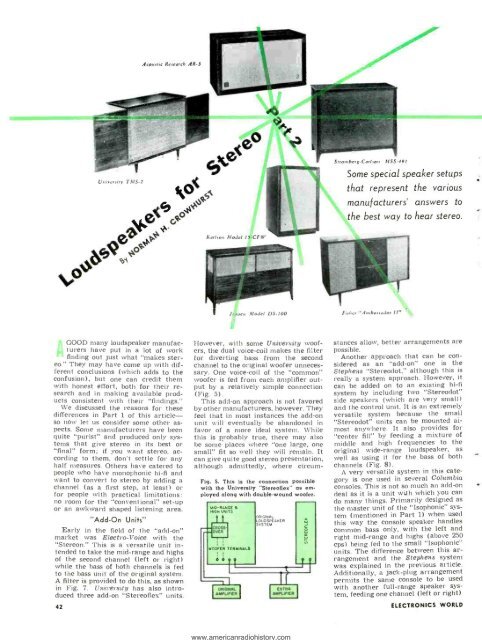Electronics-World-1959-05
You also want an ePaper? Increase the reach of your titles
YUMPU automatically turns print PDFs into web optimized ePapers that Google loves.
www.americanradiohistory.com<br />
Acoustic Research AR -3<br />
O<br />
University<br />
Ssromberg- Carlson MSS -491<br />
Some special speaker setups<br />
that represent the various<br />
manufacturers' answers to<br />
the best way to hear stereo.<br />
?Carlson Model 1 S -CFW<br />
'en Model DS100 Fisher "Ambassador 11"<br />
GOOD many loudspeaker manufacturers<br />
have put in a lot of work<br />
A finding out just what "makes stereo."<br />
They may have come up with different<br />
conclusions (which adds to the<br />
confusion), but one can credit them<br />
with honest effort, both for their research<br />
and in making available products<br />
consistent with their "findings."<br />
We discussed the reasons for these<br />
differences in Part 1 of this article -<br />
so now let us consider some other aspects.<br />
Some manufacturers have been<br />
quite "purist" and produced only systems<br />
that give stereo in its best or<br />
"final" form; if you want stereo, according<br />
to them, don't settle for any<br />
half measures. Others have catered to<br />
people who have monophonic hi -fi and<br />
want to convert to stereo by adding a<br />
channel (as a first step, at least) or<br />
for people with practical limitations:<br />
no room for the "conventional" set -up<br />
or an awkward shaped listening area.<br />
"Add-On Units"<br />
Early in the field of the "add -on"<br />
market was Electro -Voice with the<br />
"Stereon." This is a versatile unit intended<br />
to take the mid -range and highs<br />
of the second channel (left or right)<br />
while the bass of both channels is fed<br />
to the bass unit of the original system.<br />
A filter is provided to do this, as shown<br />
in Fig. 7. University has also introduced<br />
three add -on "Stereofiex" units.<br />
42<br />
However, with some University woofers,<br />
the dual voice -coil makes the filter<br />
for diverting bass from the second<br />
channel to the original woofer unnecessary.<br />
One voice -coil of the "common"<br />
woofer is fed from each amplifier output<br />
by a relatively simple connection<br />
(Fig. 5) .<br />
This add -on approach is not favored<br />
by other manufacturers, however. They<br />
feel that in most instances the add -on<br />
unit will eventually be abandoned in<br />
favor of a more ideal system. While<br />
this is probably true, there may also<br />
be some places where "one large, one<br />
small" fit so well they will remain. It<br />
can give quite good stereo presentation,<br />
although admittedly, where circum-<br />
Fig. 5. This is the connection possible<br />
with the University "Stereoflex- as employed<br />
along with double -wound woofer.<br />
MID -RAP GE 9<br />
GM UNITS<br />
tt<br />
-AOYER<br />
CROSSI<br />
OOFER TERMINALS<br />
6611<br />
ORIGINAL<br />
LOUDSPEAKER<br />
SYSTEM<br />
E TRA<br />
I AMPLIFIER<br />
stances allow, better arrangements are<br />
possible.<br />
Another approach that can be considered<br />
as an "add -on" one is the<br />
Stephens " Stereodot," although this is<br />
really a system approach. However, it<br />
can be added on to an existing hi -fi<br />
system by including two "Stereodot"<br />
side speakers (which are very small)<br />
and the control unit. It is an extremely<br />
versatile system because the small<br />
"Stereodot" units can be mounted almost<br />
anywhere. It also provides for<br />
"center fill" by feeding a mixture of<br />
middle and high frequencies to the<br />
original wide -range loudspeaker, as<br />
well as using it for the bass of both<br />
channels (Fig. 8).<br />
A very versatile system in this category<br />
is one used in several Columbia<br />
consoles. This is not so much an add -on<br />
deal as it is a unit with which you can<br />
do many things. Primarily designed as<br />
the master unit of the "Isophonic" system<br />
(mentioned in Part 1) when used<br />
this way the console speaker handles<br />
common bass only, with the left and<br />
right mid -range and highs (above 250<br />
cps) being fed to the small "Isophonic"<br />
units. The difference between this arrangement<br />
and the Stephens system<br />
was explained in the previous article.<br />
Additionally, a jack -plug arrangement<br />
permits the same console to be used<br />
with another full -range speaker system,<br />
feeding one channel (left or right)<br />
ELECTRONICS WORLD



